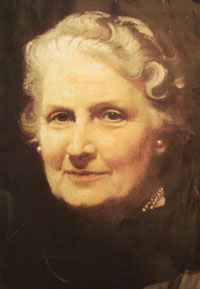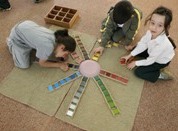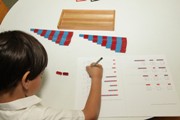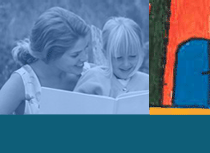
Dr. Maria Montessori
founded a theory of education that has had a
profound influence on the lives of thousands of
children throughout the world since the
beginning of the 20th Century. She wrote that
education should "… help the individual from
birth and protect his environment". From this
crucial idea the whole of Montessori's theory,
her recommendation for educational practice
including the organisation of the environment,
the curriculum and the important role of the
educator, have developed.
The Montessori Method is
an approach to education used predominantly in
the pre-school field. It is also used at the
Junior, Middle and Senior levels. From being
rather obscure and elitist, the method has now
been widely adopted and there are now well over
five thousand Montessori schools in North
America, one thousand schools in the United
Kingdom and several more thousand throughout the
world.
The Montessori approach to
education requires that children are placed in a
well-planned and structured environment which
will meet their individual educational and
cultural needs. The children are free to follow
their own interests within this planned
environment, rather than being forced to learn
something that is inappropriate to their
developmental stage. The result is that children
develop in a natural way and are highly
motivated. They develop good discipline and
master basic skills, and in many cases earlier
than in a more traditional system of education.
To bring about these results the teacher is
trained in specific skills, the curriculum is
carefully planned to reflect the children’s own
culture and educational needs, the support
materials for the curriculum are specifically
Montessori and the outcomes for the children are
unique.
There are three basic elements of the Montessori approach to education:
The Structured Environment
This is referred to as the
‘Prepared Environment’ and by this is meant the
physical appearance and the arrangement of the
learning materials adhering to certain
principles which focus on meeting the needs of
the ‘whole child’. It is the teacher’s role to
prepare and maintain this environment. These
principles encompass:
- freedom of movement and freedom of choice for the children
- structure and order in the arrangement and sequence of the materials
- an atmosphere that is attractive, warm and inviting
- materials that provide active learning experiences
- vertical grouping
(in the age ranges 2˝ to 6 years)
- a closeness to nature and the natural world and activities and materials that reflect the reality of life, not fantasy

The classrooms are
‘open-plan’ with the learning materials arranged
in areas and the children are given freedom to
move around and to choose the activities that
interest them. For the most part the materials
themselves are self-correcting and this gives
the children a sense of empowerment and helps
them to become independent learners. This type
of classroom is different from the traditional
adult-centred classrooms where children often
participate passively as teachers endeavour to
impart knowledge and skills to be learned. The indoor environment is arranged in Montessori areas for a Pre-school classroom (Nursery, Kindergarten 1 and Kindergarten 2) as described below in the Montessori Curriculum:
The indoor environment is
arranged in Montessori areas for a Pre-school
classroom (Nursery, Kindergarten 1 and
Kindergarten 2) as described below in the
Montessori Curriculum:
In each Montessori area
there are low level shelves which children can
reach and where the learning materials are
displayed in a sequential order. The children
make choices about what they want to do and
after the activity they are encouraged to put
the materials back in the correct place in
readiness for the next child. This external
structure and order helps the child build his
internal order.
The outdoor environment is
important. First and foremost the school should, by
preference, be located in a natural environment,
with trees, bushes, plants and animals to ensure
that the children remain in touch with and close to
nature. In addition there will be attractive and
safe equipment to encourage the development of
different physical skills, as well as to provide
opportunities for children to socialise with each
other.
The Montessori classrooms
are always attractive, warm and inviting and
there are plenty of materials which reflect the
children’s own culture. However, the classrooms
should not be over-stimulating but rather have a
calming effect.
The Montessori learning
materials are the tools which provide the
children with ‘hands on’ active learning
experiences. Through this direct experience and
the process of discovery and investigation the
children gradually progress from the concrete to
the abstract. Maria Montessori designed
materials for children in the Pre-school and in
the Junior school. In the Middle and Senior
schools practical investigation and the
application of research methods are encouraged.

A Montessori school will
have vertical groups. Ideally these age groups
will range from 2˝ to 6 years, 6 to 9 years, 9
to 12 years, 12 to 15 years and 15 to 18 years
but the arrangement of the age groups will
depend on the national requirements of each
country and the examination system for which the
children are being prepared.
The principle of reality,
not fantasy, in the classroom is one of the
distinguishing features of a Montessori
Pre-school classroom. Montessori’s idea was to
teach the children all about how to live in the
real world and the Exercises of Practical Life
are the first activities that provide these
experiences. Children learn how to look after
themselves and the environment as well as how to
behave socially. In a traditional Pre-school
classroom there is usually a ‘home corner’ where
the children play-out different aspects of
living, but in the Montessori classroom they
will actually engage in helping prepare the
vegetables for lunch, they will really wash up
after the meal and they will really dust and
clean their classroom.
The principle of closeness
to nature is another distinguishing feature of a
Montessori setting. In the classroom the
children will have pets for whom they are
responsible and plants and flowers to water and
tend. In the outdoor area there is a garden plot
especially for the children to cultivate where
they grow vegetables and flowers.

The Montessori Curriculum
There is a framework which specifies learning outcomes and the knowledge and skills to be learned. It is divided into the Montessori areas of learning:
- Practical Life
- Sensorial
- Mathematics
- Language and Literacy
- Cultural Subjects (which include Geography, History, Natural Sciences, Experimental Sciences)
- Creative Subjects (Art and Craft, Music and Movement, Drama)
The National or International curricula which are required to be followed in a particular country are taken into consideration when designing a curriculum for a particular school.
The Montessori Teacher
Initially the
Montessori teacher carefully observes
the children in her class to ascertain the
developmental needs of each individual child.
Then comes the task of preparing the environment
and the materials in it to meet the various
needs of the individual children within the
group. As the children begin to make free
choices and interact and discover the materials,
the teacher facilitates and
guides their learning. There are some
small group lessons when the teacher introduces
new concepts and encourages the children to ask
questions, investigate and discover new ideas.

As
a result,
children who experience a Montessori education
are highly motivated and learn to be
independent, self-confident and
self-disciplined. It makes education a source of
pleasure for them - something to be sought and
enjoyed. Each and all are given the opportunity
to develop their own innate abilities to the
full potential in an atmosphere where
competition is irrelevant and non-existent. As a
result they develop drive and a high level of
achievement.

|



